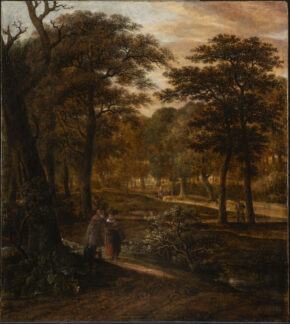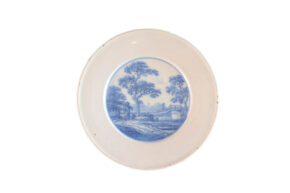
[popup_trigger id=”13756″ tag=”span”]![]() [/popup_trigger]
[/popup_trigger]
Images on this website are licensed under a
Creative Commons Attribution-NoDerivs 3.0 Unported License.
OBJECT
•D1910. Blue and White Garniture
Delft, circa 1690
Each marked GK in blue for Gerrit Pietersz. Kam, the owner of De Drie Posteleyne Astonne (The Three Porcelain Ash-Barrels) factory from 1673 until 1700
Comprising two ovoid jars, two bottle vases and an attenuated ovoid bottle with a flaring cylindrical neck; each painted in an Eastern style with three or four rotund teardrop-shaped panels centering a six-petal blossom surrounded by leaves on a stippled ground, alternating with similarly decorated small diamond-shaped panels issuing scrolls and ‘ribbons’ partially surrounding the larger panels, the cylindrical necks of the bottle vases similarly decorated but with two panels of each shape, and the lower body of each with blossoms alternating with triple circlets above a chevron-and-dot border repeated around the rim.
Heights: 13 to 21.6 cm. (5.1 to 8.5 in.)
Provenance: The ovoid bottle from the collection of Dr. F. H. Fentener van Vlissingen (1882-1962), Utrecht, and thence by family descent LITERATURE The bottle was described and illustrated in De Jonge 1947, p. 211, pl. 185 & Aronson 2008, p. 37, no. 20.
Note: The design and display of garnitures follows the evolution of interior design in Europe, specifically the central role of ornamental ceramics. The fashion for grouping vases on mantels was a typical European phenomenon. With the Chinese porcelain wares, the objects were often acquired, or later commissioned, in pairs and displayed symmetrically on a mantelpiece, above a door or on a piece of furniture, such as a cabinet. At the end of the seventeenth century, the first Dutch Delftware garnitures were created, existing of three, five, seven and sometimes even more pieces. The present garniture is inspired by both Chinese and Eastern wares. Buddhist nimbus motifs are alternated by a scroll and ribbon motif that shows similarities with the long floral plant motifs that are often seen on Eastern wares. Chinese porcelain and ornamental motifs traveled through flourishing trade routes, resulting in a lasting influence on the development of Eastern art. Contacts with Mediterranean countries also stimulated cross-fertilization in the arts with Europe.








